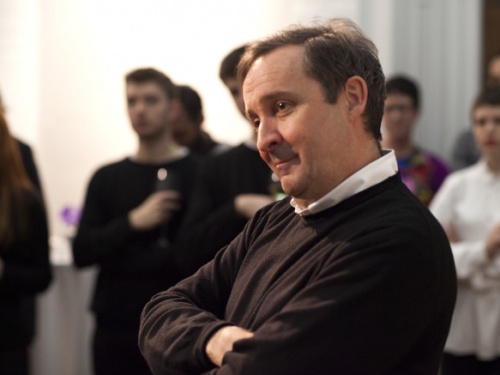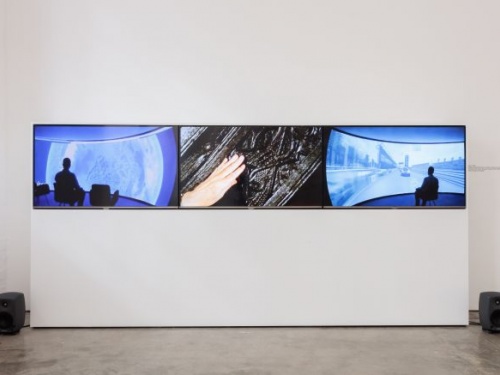Hannah Sawtell and Surplus Desire
Hannah Sawtell's exhibition Osculator is currently on display from 9 October to 18 November. She was recently interviewed by Mousse Magazine about the sources of her work, which we've republished here:
Osculator and Vendor will respectively occupy the spaces of ICA and Bloomberg Space in London. Could you tell us how the exhibitions have been developed? Were the projects conceived as a unique continuum?
When the ICA approached me, the fact that Bloomberg is a funder of the arts in UK and a centre of market driven media pre-supposed the link between the two shows. They both follow the cycle of capital and art production, employing emblems from the various stages involved in this eternal return or self perpetuating system. Beginning with speculation and investment, raw materials are sourced and exploited via labour and investment in technologies; the development of new machines to aid extraction. Production and deployment strategies ensure that the global digital advertising machine (the image) and other facets of spectacle and surplus value create an appetite for the nascent product prior to availability (the mining truck and the monster truck in the video installation Osculator at the ICA) Subsidiary funding is sought and stocks/shares are floated. Bloomberg watches this flow and reports. Funds, product and image/aspiration are flooded into the market place, new subsidiary markets evolve and the cycle begins again. At Bloomberg I take the title of the Vendor (the name Bloomberg gives to staff with semi autonomy), and I propose it for the artist as agent of collective cultural currency, subjective harbinger of desire, authorship and a small business, etc. During my time in the offices the news feed covered stories such as the massacre of South African platinum mine workers, the Paralympics and the rising price of ‘food commodities’ and yachts.
The web space has fastened the process of sharing, effecting the way cultural forms are consumed. The relation between over-production and over-consumption has become almost instantaneous. How do you approach questions related to production in your own practice?
The most generative part of the potential of the internet is for it to act as a virtual commons. But it has increasingly become what I call the 'autocracy of choice machine', which probably means I’ve spent too much time on the web. To me though its just another space and functions like many within spectacle and capital; hierarchies mutate but prevail and space is controlled by ownership. For example, music now on YouTube is often prefixed by an advert and file sharing sites that were once so strong and independent, are now policed. Copyright wins again. Image is now the surface of capital; we read everything through its surfaces and smells. This epoch is characterised by a global flow of virtual skin, and the entropic nature of the components of this fall-out are soaked in the fetishism of surplus desire. Ready to be subsumed and replicated endlessly. You could say I scoop or grab and re-configure these bits, in order to arrest this trend and subvert the cadence. I want to salvage images and create physical archives from the virtual. The re-use of skin! Its like dust full of colonized particles…Buy a good anti-allergy hoover.
Could you tell us what's the internal logic on the selection, re-editing and re-contextualization of images and cultural detritus at the core of your sculptures and video works, and its associative criteria?
I search, find, take, borrow, use and purchase, mining the ‘contemporary global arcade'. Like everyone does, the rioter and the banker. In terms of images, I respond to what I find; the image has a resonance and timbre, in addition to more obvious qualities such as commodity or surplus. I edit automatically, the overiding impulse is to splice, re-appropriate and re-deploy. The internal logic is determined by my direct relationship to each image as well as its original utility or context. The work is in the negotiation of the combined qualities of the image. Affect and politic. I leave the marks of making in the works, sound and video is produced, without cleaning up, leaving the glitches in the edits. I want to force the screen to present the visual noise of materiality and digital production. These are porous collisions, proposing agency for the user as politicised subject and collective.
The ways labour, consumption and production have been perceived and organized til now are dramatically changing, and ask for a new set of rules and answers for their re-organisation. What possible scenarios and issues, do you forecast for the near future?
I don't have a crystal ball, just a screen for a lens. But I can only distinguish or forecast subtle changes of syntax within extended labour. The language of production gets appropriated, aborted and adopted, but the fundamental underpinning stays the same. In terms of production and consumption in the West, space is needed to store the hard drives with the information that feeds the global flow of seeming 'freeness'. Call centers are in India, companies collapse and another one rises, the morning movers sip coffee and tot up another share quota of fair quota. Companies like Apple are taking over, and the workers who make their machines burn effigies of the iphone to protest against bad working conditions. Its a recurring terminal disease.Virtual tectonics and landscapes will exercise power in new areas and opportunities, and this will move with each epoch, oil and information are geopolitical commodities.
This interview is re-published with the permission of Mousse Magazine.
To view more images from the exhibitions, please visit their site.
Coinciding with the exhibition by Hannah Sawtell, Osculator, Maria Fusco, Diedrich Diederichsen and John Roberts came together for a talk at the ICA, Surplus Desire, in which they spoke about the cycle of overproduction, surplus value, and cultural fetishism.
This article is posted in: Articles, Exhibitions, Video
Tagged with: Exhibitions, hannah sawtell





